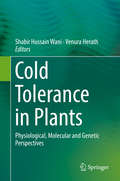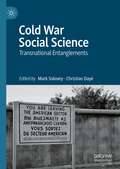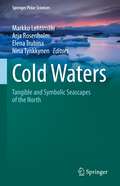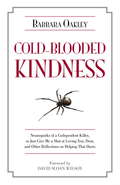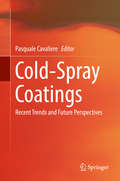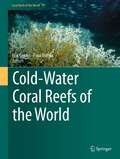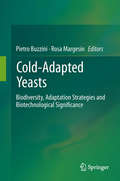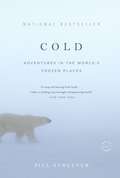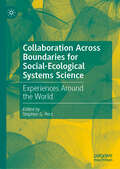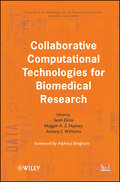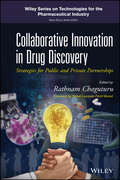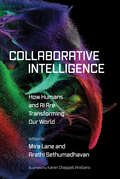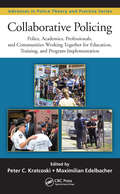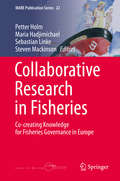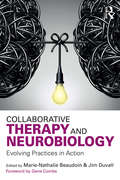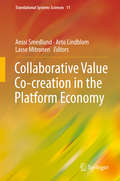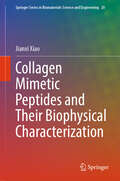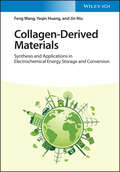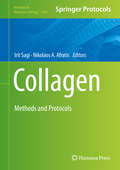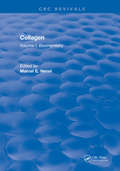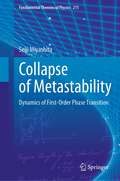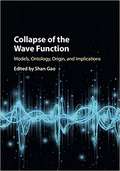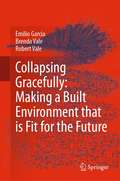- Table View
- List View
Cold Tolerance in Plants: Physiological, Molecular and Genetic Perspectives
by Shabir Hussain Wani Venura HerathCold stress is one of the prevalent environmental stresses affecting crop productivity, particularly in temperate regions. Numerous plant types of tropical or subtropical origin are injured or killed by non-freezing low temperature, and display a range of symptoms of chilling injury such as chlorosis, necrosis, or growth retardation. In contrast, chilling tolerant species thrive well at such temperatures. To thrive under cold stress conditions, plants have evolved complex mechanisms to identify peripheral signals that allow them to counter varying environmental conditions. These mechanisms include stress perception, signal transduction, transcriptional activation of stress-responsive target genes, and synthesis of stress-related proteins and other molecules, which help plants to strive through adverse environmental conditions. Conventional breeding methods have met with limited success in improving the cold tolerance of important crop plants through inter-specific or inter-generic hybridization. A better understanding of physiological, biochemical and molecular responses and tolerance mechanisms, and discovery of novel stress-responsive pathways and genes may contribute to efficient engineering strategies that enhance cold stress tolerance. It is therefore imperative to accelerate the efforts to unravel the biochemical, physiological and molecular mechanisms underlying cold stress tolerance in plants.Through this new book, we intend to integrate the contributions from plant scientists targeting cold stress tolerance mechanisms using physiological, biochemical, molecular, structural and systems biology approaches. It is hoped that this collection will serve as a reference source for those who are interested in or are actively engaged in cold stress research.
Cold War Social Science: Transnational Entanglements
by Mark Solovey Christian DayéThis book explores how the social sciences became entangled with the global Cold War. While duly recognizing the realities of nation states, national power, and national aspirations, the studies gathered here open up new lines of transnational investigation. Considering developments in a wide array of fields – anthropology, development studies, economics, education, political science, psychology, science studies, and sociology – that involved the movement of people, projects, funding, and ideas across diverse national contexts, this volume pushes scholars to rethink certain fundamental points about how we should understand – and thus how we should study – Cold War social science itself.
Cold Waters: Tangible and Symbolic Seascapes of the North (Springer Polar Sciences)
by Arja Rosenholm Elena Trubina Markku Lehtimäki Nina TynkkynenThis book addresses the Arctic and the northern regions by exploring cold waters and northern seascapes. It focuses on cultural discourses and artistic representations concerning the human experience and imagination of how the Arctic Ocean has been explored and used. It aims to assess what is specific to the northern waters vis-à-vis other sea and water areas in the world. The contextual background is provided by the fundamental shift from terra-based thinking towards aqua-based thinking, including the histories of the northern waters and the innovative ocean studies of the last decades. This book will be of interest to readers in Arctic studies and Sea and Ocean studies (including those with interests in literature, history, cultural and film studies, anthropology and politics), Environmental History and Cultural studies as well as in Russian studies. The book has been assembled with a view towards upper-level undergraduate and post-graduate students and scholars and will also be appropriate for courses in the fields mentioned above. The book will be of interest to specialists working in and with Arctic environmental issues. There is a broad array of international academic networks, environmental, governance and cultural associations outside academia whose members may also find the book of interest.
Cold-Blooded Kindness
by Barbara OakleyAre some people predisposed to kindness to the point of being destructive to themselves and others? How much of our help is fulfilling our own needs--including those of our hidden passions? This is the true story of Carole Alden, a brilliant, yet eccentric mother of five, who evinced a deep and abiding need to help society's outcasts. At her rural homestead an adopted pony mingled with llamas, goats, emus, and dozens of other creatures, familiar and exotic. But Carole's expressed desire to help others extended beyond the animals she took in. It extended beyond her meager resources, even beyond the children she insisted she loved, yet sometimes left neglected in a surreal world of danger. Finally, in the remote reaches of Utah's Great Basin, Carole Alden shot and killed her husband. Dragging his heavy body from the house, she headed for a makeshift grave. Was the murder self-defense? Premeditated? Or was something else altogether at hand? In this searing exploration of deadly codependency, the author takes the reader on a spellbinding voyage of discovery that examines the questions: Are some people naturally too caring? Is caring sometimes a mask for darker motives? Can science help us understand how our concerns for others can hurt everything we hold dear? This gripping story brings extraordinary insight to our deepest questions. Is kindness always the right answer? Is kindness always what it seems?
Cold-Spray Coatings: Recent Trends and Future perspectives
by Pasquale CavaliereThis book combines the contributions of experts in the field to describe the behavior of various materials, micromechanisms involved during processing, and the optimization of cold-spray technology. It spans production, characterization, and applications including wear resistance, fatigue, life improvement, thermal barriers, crack repair, and biological applications. Cold spray is an innovative coating technology based on the kinetic energy gained by particles sprayed at very high pressures. While the technique was developed in the 1990s, industrial and scientific interest in this technology has grown vastly in the last ten years. Recently, many interesting applications have been associated with cold-sprayed coatings, including wear resistance, fatigue life improvement, thermal barriers, biological applications, and crack repair. However, many fundamental aspects require clarification and description.
Cold-Water Coral Reefs of the World (Coral Reefs of the World #19)
by Erik Cordes Furu MienisCold-water corals form reef structures in continental margin and seamount settings world-wide, making them more wide-spread and abundant than shallow-water reefs. Their role in these ecosystems is no less important than the influence that shallow-water coral reefs have on tropical systems. They create habitat structure, host endemic species, enhance elemental cycling, alter current flow, sequester carbon, and provide many other ecosystem services that we are just beginning to understand. The rapidly evolving state of knowledge of cold-water and deep-sea coral reefs has not been compiled in over 10 years. This volume synthesizes recent and historical information, reveals new findings from reefs that have been discovered only recently, and presents key avenues for future research. We are on the cusp of understanding the critical role that cold-water coral reefs play in the world’s oceans, and this book lays the foundation on which this knowledge will be built in the future.
Cold-adapted Yeasts: Biodiversity, Adaptation Strategies and Biotechnological Significance
by Pietro Buzzini and Rosa MargesinYeasts are a versatile group of eukaryotic microorganisms, exhibiting heterogeneous nutritional profiles and an extraordinary ability to survive in a wide range of natural and man-associated ecosystems, including cold habitats. Cold-adapted yeasts inhabit numerous low-temperature environments where they are subjected to seasonal or permanent cold conditions. Hence, they have evolved a number of adaptation strategies with regard to growth and reproduction, metabolic activities, survival and protection. Due to their distinctive ability to thrive successfully at low and even subzero temperatures, cold-adapted yeasts are increasingly attracting attention in basic science and industry for their enormous biotechnological potential.This book presents our current understanding of the diversity and ecology of cold-adapted yeasts in worldwide cold ecosystems, their adaptation strategies, and their biotechnological significance. Special emphasis is placed on the exploitation of cold-adapted yeasts as a source of cold-active enzymes and biopolymers, as well as their benefits for food microbiology, bioremediation and biocontrol. Further, aspects of food biodeterioration are considered.
Cold: Adventures in the World's Frozen Places
by Bill StreeverFrom avalanches to glaciers, from seals to snowflakes, and from Shackleton's expedition to "The Year Without Summer," Bill Streever journeys through history, myth, geography, and ecology in a year-long search for cold--real, icy, 40-below cold. In July he finds it while taking a dip in a 35-degree Arctic swimming hole; in September while excavating our planet's ancient and not so ancient ice ages; and in October while exploring hibernation habits in animals, from humans to wood frogs to bears. A scientist whose passion for cold runs red hot, Streever is a wondrous guide: he conjures woolly mammoth carcasses and the ice-age Clovis tribe from melting glaciers, and he evokes blizzards so wild readers may freeze--limb by vicarious limb.
Collaboration Across Boundaries for Social-Ecological Systems Science: Experiences Around the World
by Stephen G. PerzCollaboration across boundaries is widely recognized as a vital requisite for the advancement of innovative science to address problems such as environmental degradation and global change. This book takes collaboration across boundaries seriously by focusing on the many challenges and practices involved in team science when spanning disciplinary, organizational, national and other divides. The authors draw on a shared framework for managing the challenges of collaboration across boundaries as applied to the science of understanding complex social-ecological systems.Teams working across boundaries on diverse social-ecological systems in countries around the world report their challenges and share their practices, outcomes and lessons learned. From these diverse experiences arise many commonalities and also some important differences. These provide the basis for a set of recommendations to any collaborators intending to use science as a tool to better understand social-ecological systems and to improve their management and governance.
Collaborative Computational Technologies for Biomedical Research
by Sean Ekins Alpheus Bingham Maggie A. Hupcey Antony J. WilliamsMethods, Processes, and Tools for Collaboration"The time has come to fundamentally rethink how we handle the building of knowledge in biomedical sciences today. This book describes how the computational sciences have transformed into being a key knowledge broker, able to integrate and operate across divergent data types."-Bryn Williams-Jones, Associate Research Fellow, PfizerThe pharmaceutical industry utilizes an extended network of partner organizations in order to discover and develop new drugs, however there is currently little guidance for managing information and resources across collaborations. Featuring contributions from the leading experts in a range of industries, Collaborative Computational Technologies for Biomedical Research provides information that will help organizations make critical decisions about managing partnerships, including: Serving as a user manual for collaborations Tackling real problems from both human collaborative and data and informatics perspectives Providing case histories of biomedical collaborations and technology-specific chapters that balance technological depth with accessibility for the non-specialist readerA must-read for anyone working in the pharmaceuticals industry or academia, this book marks a major step towards widespread collaboration facilitated by computational technologies.
Collaborative Innovation in Drug Discovery: Strategies for Public and Private Partnerships (Wiley Series on Technologies for the Pharmaceutical Industry #12)
by Rathnam Chaguturu Ferid MuradCan academia save the pharmaceutical industry? The pharmaceutical industry is at a crossroads. The urgent need for novel therapies cannot stem the skyrocketing costs and plummeting productivity plaguing R&D, and many key products are facing patent expiration. Dr. Rathnam Chaguturu presents a case for collaboration between the pharmaceutical industry and academia that could reverse the industry's decline. Collaborative Innovation in Drug Discovery: Strategies for Public and Private Partnerships provides insight into the potential synergy of basing R&D in academia while leaving drug companies to turn hits into marketable products. As Founder and CEO of iDDPartners, focused on pharmaceutical innovation, Founding president of the International Chemical Biology Society, and Senior Director-Discovery Sciences, SRI International, Dr. Chaguturu has assembled a panel of experts from around the world to weigh in on issues that affect the two driving forces in medical advancement. Gain global perspectives on the benefits and potential issues surrounding collaborative innovation Discover how industries can come together to prevent another "Pharma Cliff" Learn how nonprofits are becoming the driving force behind innovation Read case studies of specific academia-pharma partnerships for real-life examples of successful collaboration Explore government initiatives that help foster cooperation between industry and academia Dr. Chaguturu’s thirty-five years of experience in academia and industry, managing new lead discovery projects and forging collaborative partnerships with academia, disease foundations, nonprofits, and government agencies lend him an informative perspective into the issues facing pharmaceutical progress. In Collaborative Innovation in Drug Discovery: Strategies for Public and Private Partnerships, he and his expert team provide insight into the various nuances of the debate.
Collaborative Intelligence: How Humans and AI Are Transforming Our World
by Mira Lane and Arathi SethumadhavanA deep look into the multifaceted landscape of artificial intelligence, considering AI&’s ethical and societal implications and celebrating its diverse and innovative applications.In this edited collection Collaborative Intelligence, Mira Lane and Arathi Sethumadhavan embark on a captivating exploration of artificial intelligence. The book delves deeply into the dynamic interplay between theory and practice, shedding light on the transformative potential and complexities of AI. For practitioners deeply immersed in the world of AI, Lane and Sethumadhavan offer firsthand accounts and insights from technologists, academics, and thought leaders, as well as a series of compelling case studies, ranging from AI's impact on artistry to its role in addressing societal challenges like modern slavery and wildlife conservation.As the global AI market burgeons, this book enables collaboration, knowledge sharing, and interdisciplinary dialogue. It caters not only to the practitioners shaping the AI landscape but also to policymakers striving to navigate the intricate relationship between humans and machines, as well as academics. Divided into two parts, the first half of the book offers readers a comprehensive understanding of AI's historical context, its influence on power dynamics, human-AI interaction, and the critical role of audits in governing AI systems. The second half unfolds a series of eight case studies, unraveling AI&’s impact on fields as varied as healthcare, vehicular safety, conservation, human rights, and the metaverse. Each chapter in this book paints a vivid picture of AI&’s triumphs and challenges, providing a panoramic view of how it is reshaping our world.
Collaborative Policing: Police, Academics, Professionals, and Communities Working Together for Education, Training, and Program Implementation (Advances in Police Theory and Practice)
by Peter C. Kratcoski Maximilian Edelbacher"The chapters in this book reveal that police education, training, and practices are now closely tied to collaboration between police, academics, professional practitioners, and community agencies, and such collaboration is described and evaluated." Dilip K. Das, PhD, Founding President, International Police Executive Symposium (IPES) and founding
Collaborative Research in Fisheries: Co-creating Knowledge for Fisheries Governance in Europe (MARE Publication Series #22)
by Sebastian Linke Petter Holm Maria Hadjimichael Steven MackinsonThis book is about the ongoing transition of fisheries governance, from top-down command and control towards a more transparent and participatory form. It focuses on the emergence of research practices and advice frameworks that allow co-creation of common knowledge bases for management. Drawing from 8 years of research in GAP, a two-stage 7th framework EU project, the book offers a critical examination of how knowledge practices in fisheries governance are changing. The entry point for this research is a series of practical experiments in the unchartered terrain of collaborative research. To gain insight into the ongoing transition in European fisheries management, GAP initiated and carried out 13 Case Studies in different settings across Europe. In each case study, a team of fishers and marine scientists worked together to identify, plan and implement research projects intended to make a difference. The cases vary. They take on different management issues and shape the collaborations in different ways. The extent to which they succeed in realizing their objectives also differs. They are all contributing important insights into the possibilities of co-creating knowledge for management purposes. The book delves into the individual experiences of each case study as well as the lessons they contribute as a whole. The examination concludes that while research partnerships are not always easy to establish, they are an important step towards better fisheries governance. Without a common knowledge base for fisheries governance, co-created through collaborative research practices, sustainable fisheries will remain out of reach.
Collaborative Therapy and Neurobiology: Evolving Practices in Action
by Jim Duvall Marie-Nathalie BeaudoinCollaborative Therapy and Neurobiology is the book many clinicians have been waiting for: an integration of twenty years of scientific and therapeutic cutting-edge ideas into concrete clinical practices. Interpersonal neurobiology and the development of exciting new technologies that allow us to better understand the brain have provided us with an enriched perspective on human experience. Yet, many clinicians wonder how to use this knowledge, and how these discoveries can actually benefit their clients. In particular, what are the concrete practices that each field uses to help clients overcome the issues in their lives, and how can these fields build on each other’s ideas? Could minimally developed concepts in each field be combined into innovative and powerful practices to foster client wellbeing? This book offers a collection of writings which provide theoretical food for thought, research evidence, and most importantly hands-on, concrete clinical ideas to enrich therapists’ work with a variety of clients. Illustrated with numerous transcripts of conversations and clinical stories, the ideas in this book will stimulate the work of people interested in renewing their practice with new ideas.
Collaborative Value Co-creation in the Platform Economy (Translational Systems Sciences #11)
by Anssi Smedlund Arto Lindblom Lasse MitronenThis book offers a service science perspective on platform orchestration and on collaborative consumption, providing an overview of research topics related to service dominant logic in multi-sided markets. The chapters give an international and multi-disciplinary overview of the current topics of digital service platforms from many angles. This overview helps in filling the gap between service science and recent research of the platform economy and paves the way for future service platform research. Open standards and distributed databases such as blockchain configurations increase the connectivity of business ecosystems as devices and systems exchange data with each other instead of through intermediaries. This exchange opens up opportunities for new value constellations, makes services globally scalable, and connects local service systems as integrated systems of systems. The book brings together established academics from a number of disciplines. This collaboration makes it possible to provide novel constructs and empirical results that help the reader to understand how value is co-created and orchestrated in the era of digital service platforms. In addition to theory building, practical implications for wider managerial and policy use are highlighted. The topics in this book are related to service platform technologies; organizational capabilities; and strategies and management in the contexts of retail, healthcare, and the public sector. A wide selection of case studies is used to demonstrate the implications of platforms for different service and economic contexts. Combining both theory and practice, this book is highly recommended for readers interested in the service and marketing point of view on the platform economy and for practitioners strategizing for scalable service platforms.Chapters 4 and 10 are available open access under a Creative Commons Attribution 4.0 International License via link.springer.com.
Collagen Biografts for Tunable Drug Delivery (SpringerBriefs in Applied Sciences and Technology)
by Rucha JoshiThis book reviews collagen-based biomaterials that have been applied broadly to tissue engineering and local drug delivery applications and lays out a landscape for developing a multifunctional biograft material from collagen polymers. The book also discusses current shortcomings in collagen based drug delivery opportunities, including poor mechanical properties, rapid proteolytic degradation, and cursory control over physical properties and molecular release profiles. Finally, a review of application of the collagen biograft materials for promoting neovascularization and tissue regeneration is presented, using examples of established in-vivo chicken egg chorioallantoic membrane (CAM) model. Use of heparin for affinity-based vascular endothelial growth factor (VEGF) retention in collagen constructs is also discussed for promoting neovascularization.Reviews state-of-the-art strategies for drug incorporation and retention in collagen; Covers collagen based material applications for improving vascularization and tissue regeneration; Illustrates how to tailor collagen architecture for soft tissue engineering and controlled drug delivery.
Collagen Mimetic Peptides and Their Biophysical Characterization (Springer Series in Biomaterials Science and Engineering #20)
by Jianxi XiaoThis book embarks on an enlightening journey through the molecular landscape of collagen mimic peptides, shedding light on their significance and potential. In the intricate realm of biomolecules, collagen's preeminence as the most abundant protein in the human body, forming the foundational scaffolding of tissues and organs, renders it a subject of profound scientific interest. It explores diverse facets related to collagen mimic peptides, spanning aspects such as bioinformatic analysis, synthetic strategies, pathological collagen targeting, and the construction of homotrimeric, heterotrimeric and self-assembled peptide models. Furthermore, it provides an exhaustive investigation into biophysical techniques, encompassing Circular Dichroism (CD), X-ray crystallography, Nuclear Magnetic Resonance (NMR), Fluorescence, and Raman spectroscopy, thereby empowering researchers to unravel the structural intricacies of these peptides. The book unravels the profound implications of collagen mimic peptides across a spectrum of scientific domains, including protein science, biomaterials, bioanalysis, and beyond. Its accessibility and insights cater not only to seasoned researchers but also to undergraduate and graduate students eager to delve into the complexities of this fundamental protein.
Collagen-Based Biotextiles for Tissue Engineering
by Fan Zhang Martin W. King Tushar Bambharoliya Ting He Daxian Zha Yihan Huang Monica Vijay Deshpande Jiyang ChenBased on the author's extensive research experience in collagen textiles and tissue engineering, this book presents a comprehensive introduction and guidelines for engineering artificial tissue using collagen-based fibrous material as a therapeutic candidate for regenerative medicine. The book covers different aspects of fibrous collagen material, including its chemistry, sourcing, fabrication, and applications in tissue engineering and regenerative medicine. Collagen-Based Biotextiles for Tissue Engineering provides a state-of-the-art overview of fibrous collagen-based materials and their application in tissue engineering and regenerative medicine for academic researchers, material scientists, and bioengineers.
Collagen-Derived Materials: Synthesis and Applications in Electrochemical Energy Storage and Conversion
by Feng Wang Yaqin Huang Jin Niu>Collagen-Derived Materials Comprehensive Resource for Current Ideas and Strategies for the Synthesis and Characterization of Advanced Collagen-Derived Materials This book presents and summarizes new synthetic strategies and multi-functional applications of collagen-derived materials in electrochemical energy storage and conversion. Through easily-comprehensible illustrations and images, the book presents basic knowledge for collagen-derived materials (including gelatin and collagen-derived carbons) and their typical synthesis and applications, thus enabling students and new researchers to obtain a thorough understanding of different materials and corresponding application areas. This book also serves as an important reference book for scientists and engineers in different research fields. It presents the up-to-date ideas and strategies for the synthesis and characterization of advanced collagen-derived materials, as well as multi-functional applications (especially in energy-related areas). Sample topics covered within the book include: Structural compositions, properties, and extraction of collagen and gelatin Precursors, structural compositions, and synthesis of collagen-derived carbons Applications of collagen-derived materials in electrochemical energy storage and conversion Applications of collagen-derived materials as electrode and supporting materials in the electrochemical energy storage and conversion systems, including capacitors, batteries, and electrocatalysts Challenges and opportunities for the design and synthesis of different collagen-derived materials For electrochemists, materials scientists, chemical engineers and students in related programs of study who are interested in the topic of collagen-derived materials, Collagen-Derived Materials: Synthesis and Applications in Electrochemical Energy Storage and Conversion serves as an important resource for gaining a holistic understanding of the field and learning about the state of the art based on promising energy-related applications.
Collagen: Methods and Protocols (Methods in Molecular Biology #1944)
by Irit Sagi Nikolaos A. AfratisThis detailed volume compiles state-of-the-art protocols that will serve as recipes for scientists researching collagen, an abundant protein with great importance to health and disease, as well as in applications like food, cosmetics, pharmaceuticals, cosmetic surgery, artificial skin, and glue. Beginning with a section on in vitro models for the characterization of collagen formation, the book continues by highlighting large-scale analysis of collagen with mass spectrometry in order to elucidate the proteomics, degradomics, interactomes, and cross-linking of collagen, high resolution imaging approaches for collagen by the use of scanning electron microscopy and multiphoton imaging, as well as the role of collagen during physiological and pathological conditions. Written for the highly successful Methods in Molecular Biology series, chapters include introductions to their respective topics, lists of the necessary materials and reagents, step-by-step, readily reproducible laboratory protocols, and tips on troubleshooting and avoiding known pitfalls. Authoritative and practical, Collagen: Methods and Protocols is an ideal guide to high quality and repeatable protocols in this vital field of study.
Collagen: Volume I: Biochemistry
by Marcel E. NimniThis series was conceived with the idea of integrating current aspects of ongoing research in the collagen field. The book consists of a spectrum of papers which discus divers aspects such as X-ray structure, the thermodynamics and mechanism of fibrillogenesis, and the use of collagen as a biomaterial for the manufacturing of many implantable, sometimes lifesaving, devises.
Collapse of Metastability: Dynamics of First-Order Phase Transition (Fundamental Theories of Physics #211)
by Seiji MiyashitaTo understand phenomena in nature, it is important to focus not only on properties of stationary states, but also their changes in time, that is, the dynamics between bistable states. This book reviews the mechanics of first-order phase transitions and discusses relaxation and collapses of metastable states from various viewpoints, including Kramers' method for the lifetime of metastability, Langer’s analysis on the singularity, effects of thermal fluctuation studied by Néel and Brown, and eigenvalue structures of the transfer-matrix for the phase transitions. The book also goes into the mechanics of metastability in quantum systems from the viewpoints of the eigenvalue problem of the Hamiltonian and the Liouvillian for a dynamical process and discusses relations between quantum tunneling processes and metastability therein. Lastly, the coercivity of magnets consisting of an ensemble of grains is reviewed. The book is beneficial for those new in the field as a primer on first-order phase transition from modern perspectives. The comprehensive content offers overviews of related topics and allows readers to quickly catch up with developments in the field.
Collapse of the Wave Function: Models, Ontology, Origin, and Implications
by Shan GaoThis is the first single volume about the collapse theories of quantum mechanics, which is becoming a very active field of research in both physics and philosophy. In standard quantum mechanics, it is postulated that when the wave function of a quantum system is measured, it no longer follows the Schrödinger equation, but instantaneously and randomly collapses to one of the wave functions that correspond to definite measurement results. However, why and how a definite measurement result appears is unknown. A promising solution to this problem are collapse theories in which the collapse of the wave function is spontaneous and dynamical. Chapters written by distinguished physicists and philosophers of physics discuss the origin and implications of wave-function collapse, the controversies around collapse models and their ontologies, and new arguments for the reality of wave function collapse. This is an invaluable resource for students and researchers interested in the philosophy of physics and foundations of quantum mechanics.
Collapsing Gracefully: Making a Built Environment that is Fit for the Future
by Robert Vale Brenda Vale Emilio GarciaThis innovative book investigates the concept of collapse in terms of our built environment, exploring the future transition of modern cities towards scenarios very different from the current promises of progress and development. This is not a book about the end of the world and hopeless apocalyptic scenarios. It is about understanding change in how and where we live. Collapse is inevitable, but in the built environment collapse could imply a manageable situation, an opportunity for change or a devastating reality. Collapsing gracefully means that there might be better ways to coexist with collapse if we learn more about it and commit to rebuild our civilisations in ways that avoid its worst effects. This book uses a wide range of practical examples to study critical changes in the built environment, to contextualise and visualise what collapse looks like, to see if it is possible to buffer its effects in places already collapsing and to propose ways to develop greater resilience.The book challenges all agents and institutions in modern cities, their designers and planners as well as their residents and users to think differently about built environment so as to ease our coexistence with collapse and not contribute to its causes. .
